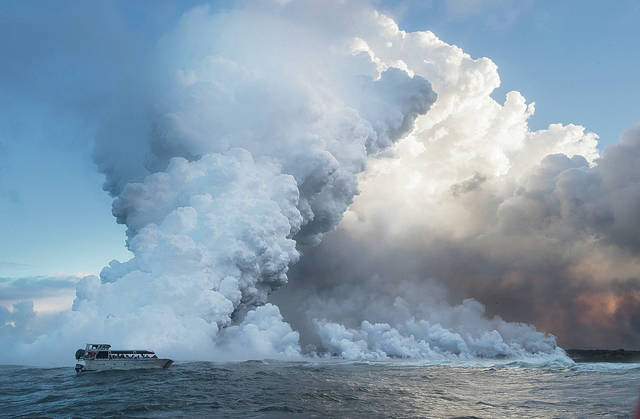Volcanic activity destroying marine and forest preserves

CINDY ELLEN RUSSELL / CRUSSELL@STARADVERTISER.COM
Lava spilled into the waters of Kapoho Bay creating a large plume of laze, June 4.
HILO >> Shoreline sites along the rugged Puna coastline aren’t the only precious natural resource endangered by the ongoing Kilauea Volcano eruption. State Department of Land and Natural Resources officials say volcanic activity in the lower East Rift Zone is spreading destruction to marine and forest preserves.
Chief among the losses is the Waiopae Tidepools Marine Life Conservation District at Kapoho Bay, where a steady flow of lava from fissure 8 in Leilani Estates has filled at least 370 acres of ocean.
Lava has completely inundated the Waiopae Tidepools, DLNR reported.
“Less than 1 percent of the marine environment in Hawaii is fully protected by these districts, so the loss of Waiopae is extremely significant,” according to a news release.
Other DLNR-managed sites impacted by the Kilauea eruption include:
>> Explosion shakes Kilauea’s summit
>> Lava has blocked road access to favorite shoreline sites
>> State leaders should be devising plans now to help volcano-impacted businesses recover
RELATED PHOTOS AND VIDEOS
>> Live webcams from Hawaii island
>> Lava river in Leilani Estates, June 23
>> Fissure 8 channel transports ‘lava boats’
>> Lava on Moku Street in Leilani Estates, June 21
>> Vigorous lava flow from fissure 8 to ocean, June 19 Opens in a new tab
>> Gas plume above Halemaumau Crater, June 18 Opens in a new tab
>> Hawaii National Guard lava river flyby, June 16 Opens in a new tab
>> Kalapana Night Market provides needed lava break for residents, June 16
>> Newly opened center is a one-stop shop for Kilauea disaster survivors on Hawaii island, June 15
>> Dramatic footage from Kilauea’s most active fissure: No. 8, June 15
>> Pahoa business owners talk about drop in business, June 14
Don't miss out on what's happening!
Stay in touch with breaking news, as it happens, conveniently in your email inbox. It's FREE!
COMPLETE KILAUEA COVERAGE
>> Star-Advertiser volcano coverage
>> Kilauea Volcano YouTube playlist
>> Lava Tree State Monument. The park has been closed since shortly after the eruption began because of its proximity to lava flows and noxious gas emissions. Visitors enjoyed the easy 0.7-mile loop trail that provides views of lava molds of tree trunks burned when flows swept through the forest.
Dean Takebayashi, DLNR’s Parks Division supervisor for Hawaii island, visited Lava Tree State Monument on Monday, observing damage to the comfort station and park walkway that likely was caused by a 6.9-magnitude earthquake May 4.
Division of Conservation and Resources officers have issued citations to dozens of sightseers caught in Lava Tree Monument and MacKenzie State Recreation Area.
>> Malama Ki Forest Reserve. About half of the 1,514-acre reserve has been closed, as lava burned much of the forest and volcanic emissions have defoliated hundreds of trees, DLNR said. The reserve provides habitat to small populations of native forest birds whose isolation has allowed them to develop resistance to avian pox and avian malaria.
“We would hate to lose that genetic pool,” said state Division of Forestry and Wildlife Hawaii island Branch Manager Steve Bergfeld in the news release.
With additional habitat loss expected, wildlife populations may become further fragmented or find their home ranges shrunk, leading to their rapid decline or extermination, he said.






